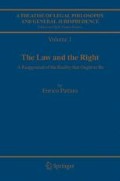Abstract
The distinction was introduced in Chapter 1 between the reality that ought to be and the reality that is. In the reality that ought to be a further distinction was made between what is objectively right (norms and their content) and what is subjectively right, meaning rights and obligations. What is subjectively right depends on the content of norms as well as on what this content refers to in the reality that is—to actual subjects (people), states of affairs, and events.
Access this chapter
Tax calculation will be finalised at checkout
Purchases are for personal use only
Preview
Unable to display preview. Download preview PDF.
Editor information
Rights and permissions
Copyright information
© 2005 Springer
About this chapter
Cite this chapter
(2005). Taking a Dive Into the Sources of Law. In: Roversi, C. (eds) A Treatise of Legal Philosophy and General Jurisprudence. Springer, Dordrecht. https://doi.org/10.1007/1-4020-3505-5_3
Download citation
DOI: https://doi.org/10.1007/1-4020-3505-5_3
Publisher Name: Springer, Dordrecht
Print ISBN: 978-1-4020-3387-2
Online ISBN: 978-1-4020-3505-0
eBook Packages: Humanities, Social Sciences and LawPhilosophy and Religion (R0)

